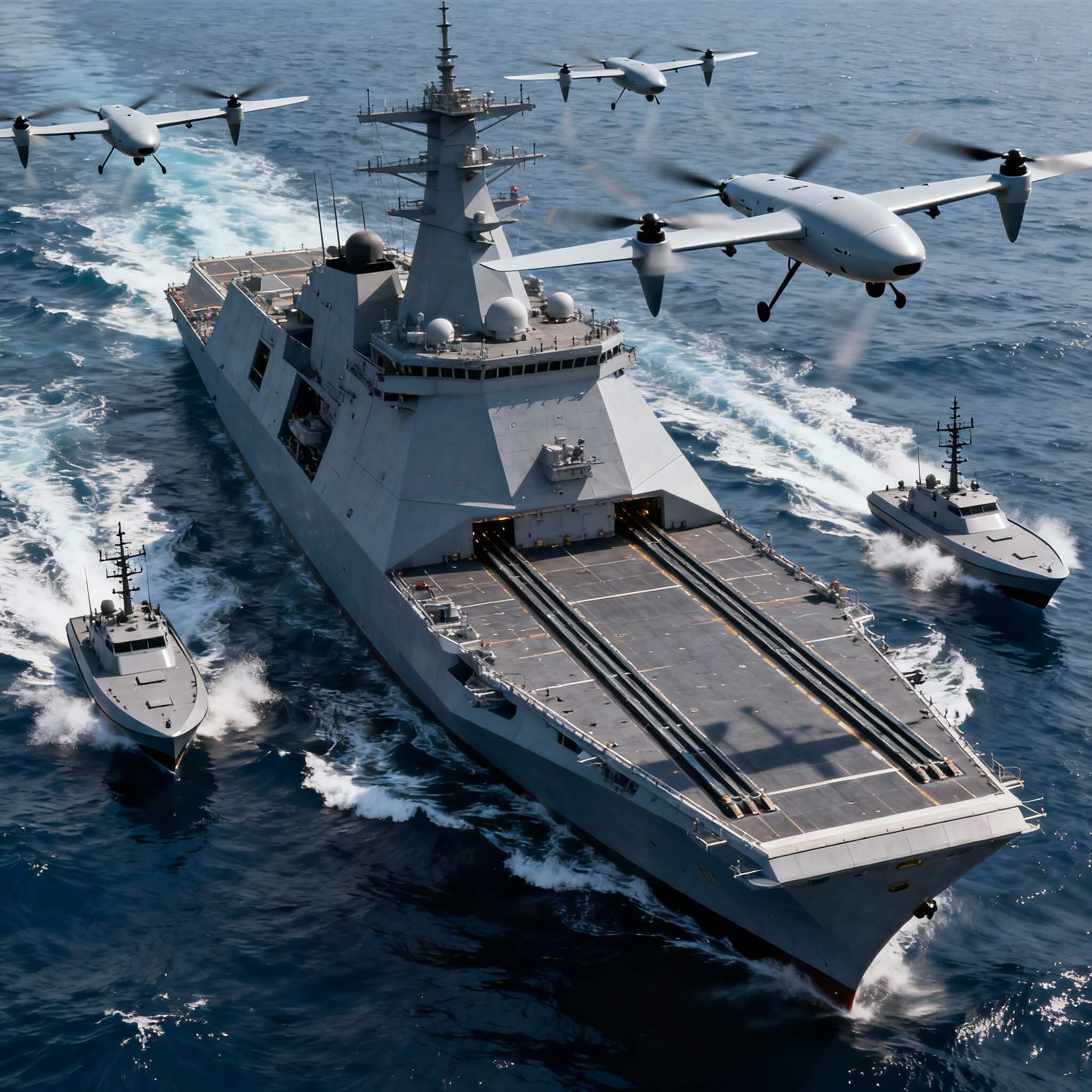Motherships, Payloads and Autonomous Systems: A 2024 Prologue
On October 21, 2025, Singapore marked a significant milestone in its naval modernization program when ST Engineering launched the first Victory-class Multi-Role Combat Vessel (MRCV) at its Benoi shipyard. This event represents not merely the addition of a new warship to the Republic of Singapore Navy (RSN), but rather a fundamental reimagining of naval warfare centered on autonomous systems and international collaboration. The MRCV program exemplifies how middle powers can leverage international partnerships to develop cutting-edge military capabilities, with Danish naval design expertise playing a particularly crucial role in shaping Singapore’s maritime future.
My next article will examine the MRCV but I wanted to republish a 2024 article which is a prologue to this fascinating development which I highlighted in my 2024 book entitled The Coming of Maritime Autonomous Systems.
This is what I published in that year about the mothership concept:
The coming of maritime autonomous systems could lead to the birth of a whole new class of capital ships as well, ones might call motherships.
They would be designed from the ground up to be part of a combat cluster and to project maritime autonomous and a new generation of unmanned air systems into the battlespace.
They could be built at the size of OPVs, frigates or destroyers with the level of self-defense defined by the relevant operational combat space on the ship to host defensive systems of various sorts.
But their raison d’etre would be to carry and operate various autonomous systems into an area of interest to support the other members of the combat cluster providing the means to contest or control the relevant area of interest.
C2 systems are crucial as well as shared situational awareness with other members of the combat cluster. The ability to link that combat cluster with strategic decision makers is important but if disrupted the combat cluster could operate with its own ISR and C2 and projection capabilities, many of which would be provided by the autonomous systems projected from the mother ships.
Once launched these systems could be controlled and operated by another member of the combat cluster, with a variable capability for C2 of these assets being a characteristic of the evolution of a combat cluster from a legacy task force.
Motherships are key building blocks within combat clusters in the kill web sense. They will be built around the payload revolution in which the focus is upon the aggregate payloads a combat cluster can deliver to the area of interest, not on the total number of platforms which are operating within an area of interest.
This means that this new class of ships would be built in an era of fifth generation warfare, the payload revolution, advanced C2, and a growing role for autonomous systems.
The fifth-generation warfare dimension is the ability to do third party targeting. For example, F-35s operating as a wolfpack provide significant targeting data for other shooters to finish the strike mission.
The payload revolution provides a wide range of payloads which the autonomous systems can carry underwater, above water or in the air.
Advanced C2 is the ability to create flexible combat clusters at the tactical edge but connect these tactical edge forces to relevant strategic decision makers.
And it is in this context that the role of the new generation autonomous systems can grow effectively, rather than being simply a disruptive and marginal science project.
Clearly, one can add a mothership capability to a capital ship by adding a particular USV, such as the MARTAC USV, in the space where a RHIB would normally be located.
A second way to think about it would be to recognize that the U.S. Navy already operates motherships in the form of its amphibious fleet. In my book on the maritime kill web written with Ed Timperlake, we argued that in a maritime kill web con-ops amphibious ships can be re-envisaged from the legacy role of land assault.
We argued:
In a way a shift is underway from the amphibious fleet operating an Amphibious Ready Group/Marine Expeditionary Unit to an amphibious task force whereby the reach and range of the Osprey-F3F-B-CH-53K combination, certainly built around the new class of LHAs can operate as modular task forces supplementing a classic carrier strike group.
They function as an expeditionary action group which can exercise sea control and sea-denial leveraging capabilities from the sea and to the sea integrated with the joint and coalition force. And building out the expeditionary seabasing enterprise can provide an additional way ahead for mobile basing as a strategic joint and coalition force capability….
In many ways, a “re-imagining” of the amphibious fleet can open up shaping new ways to build seabases — manned and autonomous systems – which can create in effect new ways to operate expeditionary seabases.
Seabasing is a key capability which the joint and coalition force needs to leverage and shape ways to integrate the force, rather than simply having the Navy focus on its own discussion of the way ahead for classic naval combat conversations.
The role of the Danes in the mothership approach is seminal. As noted in a December 12, 2023 article which we published: “Hidden in Plain Sight: The Impact of the Danes on Shaping a Way Ahead with Innovative Shipbuilding.”1
Whether it comes to designing a new ship for the Royal Navy or the next generation modular ship for its own forces, or for designing a new type of support/assault ship for Singapore, the Danes are to be found re-shaping ship design and ship building.
Sort of a 21st century version of the Peter Sellers movie of the Mouse that Roared.
The featured image was generated by an AI program and shows a notional mother ship launching various types of autonomous systems at sea.

